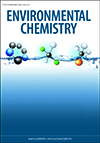Environmental context. Predicting the chemistry of metals is important for understanding their movement and impacts in the environment. Metal chemistry models are generally complex and difficult to apply, but a simpler model, which does not need large amounts of input data, can also provide good results. A simpler model can be more easily included in large scale models of metal transport and impacts in the environment.
EN21100 Abstract | EN21100 Full Text | EN21100PDF (1.9 MB) | EN21100Supplementary Material (853 KB) Open Access Article





